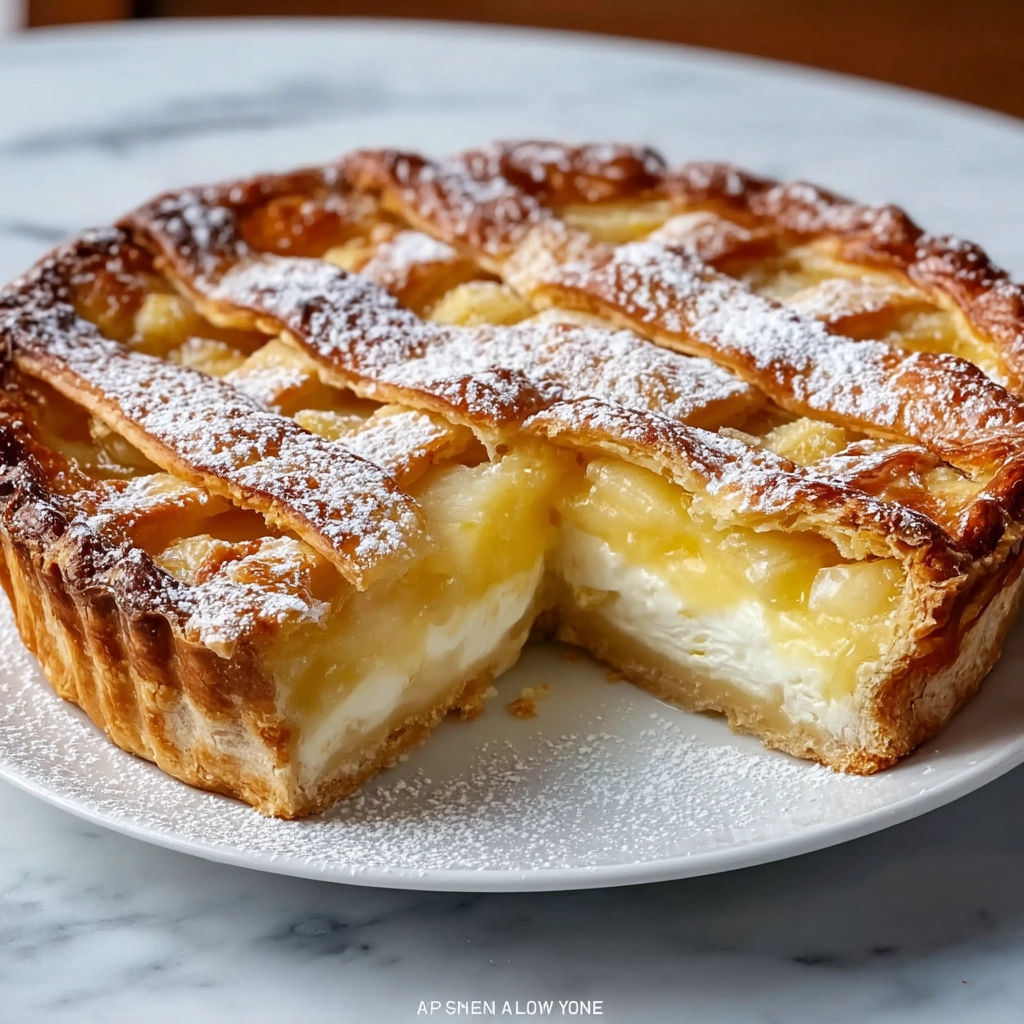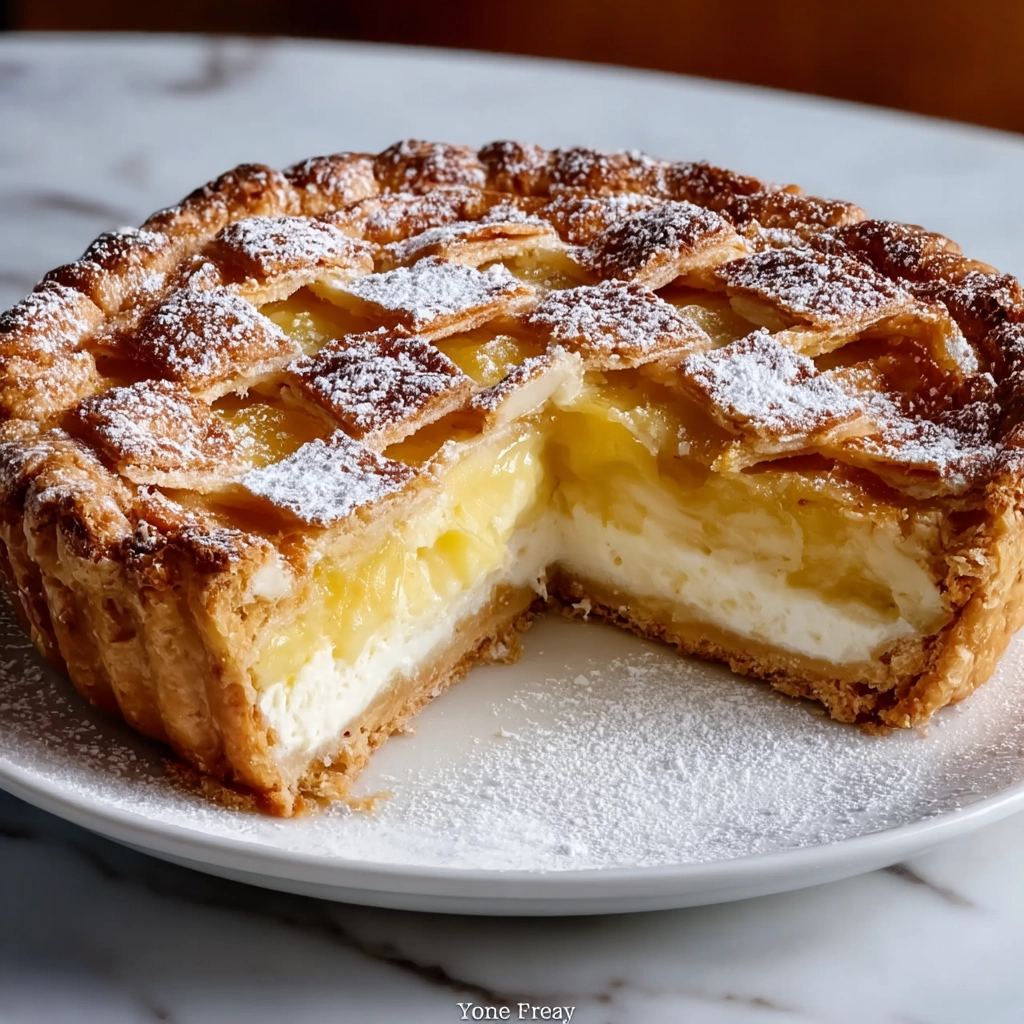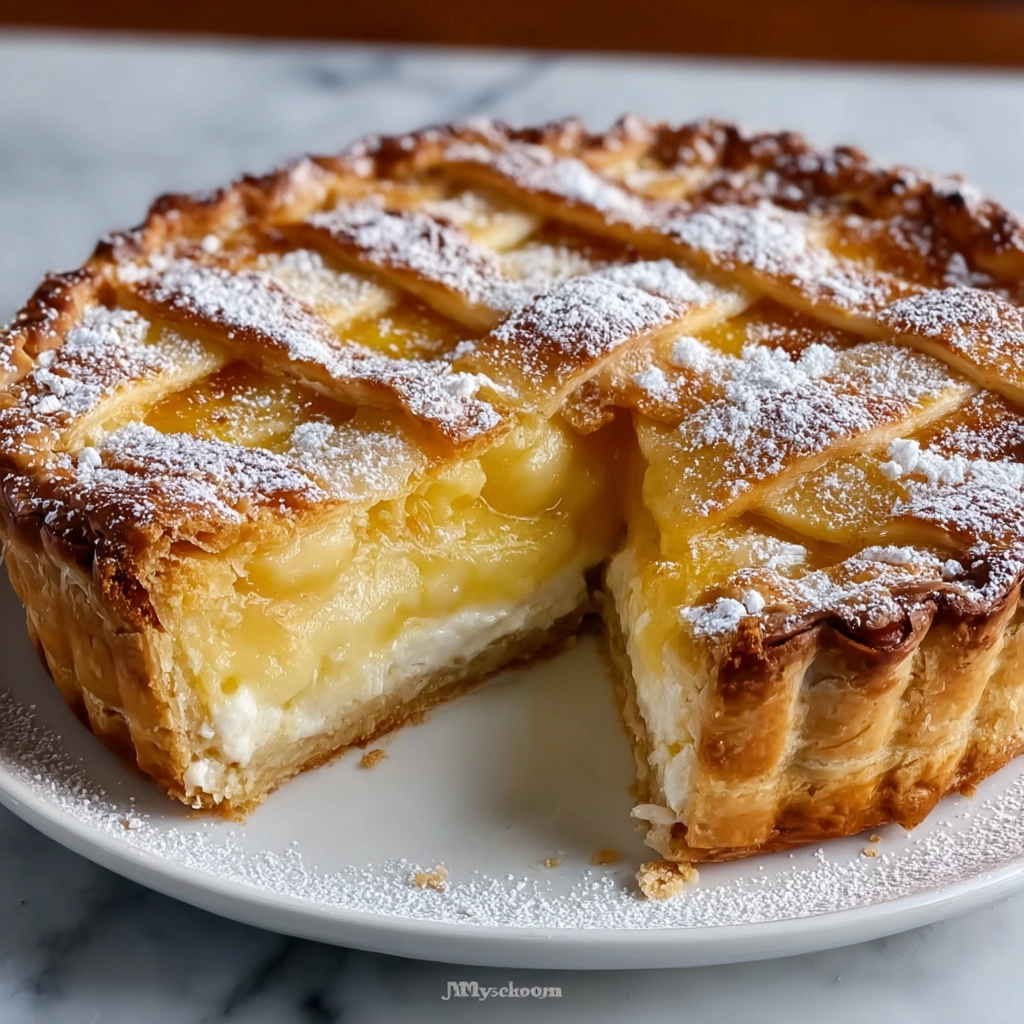If you’re looking for a festive Italian dessert that truly evokes the spirit of spring, the Italian Ricotta Easter Pie is your answer. This classic treat, hailing from Naples and known as Pastiera Napoletana, features a lusciously creamy ricotta filling fragrant with orange blossom and studded with tender wheat berries or rice. All of this is enveloped in a golden, buttery crust and finished with a charming lattice top, making it as beautiful as it is delicious. Baking an Italian Ricotta Easter Pie isn’t just about flavors and textures; it’s about sharing a slice of tradition and history with the people you love. And whether you have Italian roots or just love the magic of Easter baking, this recipe promises to create memories (and cravings) for years to come.
Ingredients You’ll Need
Don’t be intimidated by the ingredient list! Each component is simple, but together they create the incredible taste, aroma, and color that make this pie unforgettable. Let’s break down every element so you can see just how essential each is to the finished masterpiece.
- All-purpose flour: The foundation of your crust, ensuring a tender, sturdy base that won’t overwhelm the delicate filling.
- Granulated sugar: Sweetens both the crust and the filling, balancing the subtle tang of ricotta.
- Baking powder: Lends just a whisper of lift to your pastry, making it beautifully light.
- Salt: Enhances all the flavors, especially the dairy and citrus notes.
- Cold butter, diced: Creates that crisp, flaky texture in the pastry—don’t skip chilling it!
- Large eggs: Bind both crust and filling, and add golden richness throughout.
- Milk (only if needed): Just a touch, for bringing the dough together if dry—don’t add too much!
- Whole milk ricotta cheese (well-drained): The star of the filling; its creamy texture defines Italian Ricotta Easter Pie.
- Cooked wheat berries (or cooked rice): Offer hearty chew and symbolize renewal, a crucial tradition.
- Candied citron or orange peel: Little gems that add pops of sweet-tart citrus and color.
- Orange blossom water (or orange zest + vanilla): Delivers an unmistakably floral aroma—a hallmark of classic Pastiera.
- Ground cinnamon: Adds gentle warmth and subtle spice, enhancing the pie’s complexity.
- Salt (for filling): Rounds out the sweet and enhances dairy flavors.
- Powdered sugar (for serving): A final dusting turns every slice into a picture-perfect celebration.
How to Make Italian Ricotta Easter Pie
Step 1: Make the Pastry Crust
Let’s start by making that beautifully crisp pastry shell. In a bowl, combine flour, sugar, baking powder, and salt. Cut the cold butter into the mixture using your fingertips (or a pastry cutter) until you get coarse, sandy crumbs. Now, add eggs and mix until a soft dough starts to form. If your dough seems crumbly, splash in a teaspoon of milk at a time until it holds together. Shape into a disk, wrap in plastic, and chill in the fridge for at least half an hour—this rest ensures your crust is easy to handle and doesn’t shrink.
Step 2: Prepare the Baking Dish and Roll Out Dough
Preheat your oven to 350°F (175°C) and butter a 9-inch pie dish or springform pan. Roll out about two-thirds of your rested dough to roughly 1/4 inch thick and gently line your pan, pressing into the corners. Trim any extra and save it for the lattice topping. Your dough should come up the sides to create a deep, welcoming nest for that glorious filling.
Step 3: Whip Up the Ricotta Filling
In a large bowl, beat the ricotta and sugar until ultra-smooth and creamy—the more you whip, the silkier your filling will be. Add the egg yolks, one by one, beating after each addition. Now stir in your cooked wheat berries or rice, candied citrus, a drizzle of orange blossom water (or zest/vanilla), cinnamon, and a pinch of salt. The mixture should smell like a Sicilian orchard in bloom! In another clean bowl, whisk the egg whites to soft peaks, then fold them gently into your ricotta mixture. This step ensures a cloud-like texture in every bite.
Step 4: Assemble and Lattice the Pie
Pour your creamy, fragrant filling into the prepared crust and smooth the top. Next, roll out your reserved dough and cut it into long, even strips—about 1/2 inch wide. Lay the strips over the filled pie in a criss-cross pattern for that classic lattice look. Press the strip edges into the outer crust to seal. Not only is this beautiful, but it makes each slice extra inviting.
Step 5: Bake to Golden Perfection
Bake the Italian Ricotta Easter Pie for 60 to 70 minutes. The filling should be set (no wobbles in the middle) and the crust a lovely golden brown. If the top colors too quickly, tent with foil to protect it. Once baked, transfer to a wire rack and let it cool completely. For the ultimate flavor and slice-ability, chill it in the fridge for several hours or overnight—trust me, it’s worth the wait!
How to Serve Italian Ricotta Easter Pie

Garnishes
Before serving, give the Italian Ricotta Easter Pie a gentle dusting of powdered sugar. This not only makes each slice look festive, but also adds a sweet visual contrast to the golden lattice top. For special occasions, consider topping with a few candied citrus peels or delicate edible flowers for an extra pop of springtime charm.
Side Dishes
This pie shines as a stand-alone dessert, but if you’re serving it at an Easter brunch or big family meal, it pairs beautifully with fresh berries or a lightly sweetened fruit compote. Offer a pot of Italian coffee or herbal tea to balance the pie’s richness and complete the celebration.
Creative Ways to Present
For a modern twist, make mini-Italian Ricotta Easter Pies using tartlet pans—perfect for parties or sharing with friends. Another fun idea: serve slices alongside a drizzle of warm honey or a scoop of vanilla gelato for an unforgettable fusion of flavors and temperatures.
Make Ahead and Storage
Storing Leftovers
Store leftover Italian Ricotta Easter Pie wrapped well or in an airtight container in the refrigerator for up to five days. The flavors only deepen and mellow with time, so a day or two in the fridge actually enhances the experience.
Freezing
While you can technically freeze slices for longer storage, it’s not recommended. Ricotta-based fillings and buttery pastry can change texture after thawing, losing that just-baked magic you want in every bite of Italian Ricotta Easter Pie.
Reheating
This pie is at its absolute best served chilled or at room temperature. If you’d like, bring slices out of the fridge about 30 minutes before serving. Avoid microwaving—this can disrupt the delicate filling. Simply let it gently warm on the counter for an authentically Italian experience.
FAQs
Can I make Italian Ricotta Easter Pie ahead of time?
Yes, it’s traditionally prepared a day or two before Easter. In fact, the flavors harmonize wonderfully with a bit of rest—the perfect make-ahead dessert!
What if I can’t find wheat berries?
No worries at all: you can use arborio rice or pearl barley for a hearty, traditional feel. Rice is a common substitute in many Italian households and keeps the spirit of the dish alive.
How do I substitute orange blossom water?
If you can’t track down orange blossom water, simply use a mix of grated orange zest and pure vanilla extract. You’ll get the beautiful citrus and floral notes that define Italian Ricotta Easter Pie.
Can I use store-bought crust?
Absolutely! While homemade pastry adds something special, a good-quality store-bought shortcrust will save time and still deliver delicious results.
Is it possible to make mini versions?
Definitely—the recipe works beautifully in smaller tart tins for individual Italian Ricotta Easter Pies. Just shorten the baking time and keep an eye on them as they cook.
Final Thoughts
I hope you’re as excited to bake this Italian Ricotta Easter Pie as I am to share it! Whether it’s gracing your Easter table or starring at a spring brunch, this beloved classic is sure to inspire joy and spark conversation. Don’t be surprised if it becomes your new yearly tradition—happy baking and Buona Pasqua!




Very good partnership https://shorturl.fm/68Y8V
Cool partnership https://shorturl.fm/FIJkD
Cool partnership https://shorturl.fm/a0B2m
Best partnership https://shorturl.fm/A5ni8
Best partnership https://shorturl.fm/A5ni8
https://shorturl.fm/9fnIC
https://shorturl.fm/YvSxU
https://shorturl.fm/m8ueY
https://shorturl.fm/bODKa
https://shorturl.fm/XIZGD
https://shorturl.fm/FIJkD
https://shorturl.fm/N6nl1
https://shorturl.fm/bODKa
https://shorturl.fm/N6nl1
https://shorturl.fm/9fnIC
https://shorturl.fm/68Y8V
https://shorturl.fm/5JO3e
https://shorturl.fm/N6nl1
https://shorturl.fm/m8ueY
https://shorturl.fm/A5ni8
https://shorturl.fm/a0B2m
https://shorturl.fm/TbTre
https://shorturl.fm/a0B2m
https://shorturl.fm/uyMvT
https://shorturl.fm/0EtO1
https://shorturl.fm/VeYJe
https://shorturl.fm/YZRz9
https://shorturl.fm/LdPUr
https://shorturl.fm/ypgnt
https://shorturl.fm/Xect5
https://shorturl.fm/Kp34g
https://shorturl.fm/retLL
Turn referrals into revenue—sign up for our affiliate program today! https://shorturl.fm/H3qm3
Start profiting from your traffic—sign up today! https://shorturl.fm/hCQXU
Promote our brand and get paid—enroll in our affiliate program! https://shorturl.fm/5MtVb
Get paid for every referral—enroll in our affiliate program! https://shorturl.fm/jLaDa
Earn big by sharing our offers—become an affiliate today! https://shorturl.fm/AcYJQ
Boost your profits with our affiliate program—apply today! https://shorturl.fm/QjzcF
Refer and earn up to 50% commission—join now! https://shorturl.fm/zlLR4
Monetize your traffic with our affiliate program—sign up now! https://shorturl.fm/Ezqac
Grow your income stream—apply to our affiliate program today! https://shorturl.fm/YktHg
Earn passive income this month—become an affiliate partner and get paid! https://shorturl.fm/wiFmb
Promote our products—get paid for every sale you generate! https://shorturl.fm/7xS4k
Partner with us for high-paying affiliate deals—join now! https://shorturl.fm/DDLrW
Share your unique link and cash in—join now! https://shorturl.fm/ziYb4
Join our affiliate community and start earning instantly! https://shorturl.fm/yoDYx
Join our affiliate family and watch your profits soar—sign up today! https://shorturl.fm/BYYVK
Drive sales, earn big—enroll in our affiliate program! https://shorturl.fm/kwSOR
Monetize your influence—become an affiliate today! https://shorturl.fm/MzhEP
Turn your network into income—apply to our affiliate program! https://shorturl.fm/TVmwF